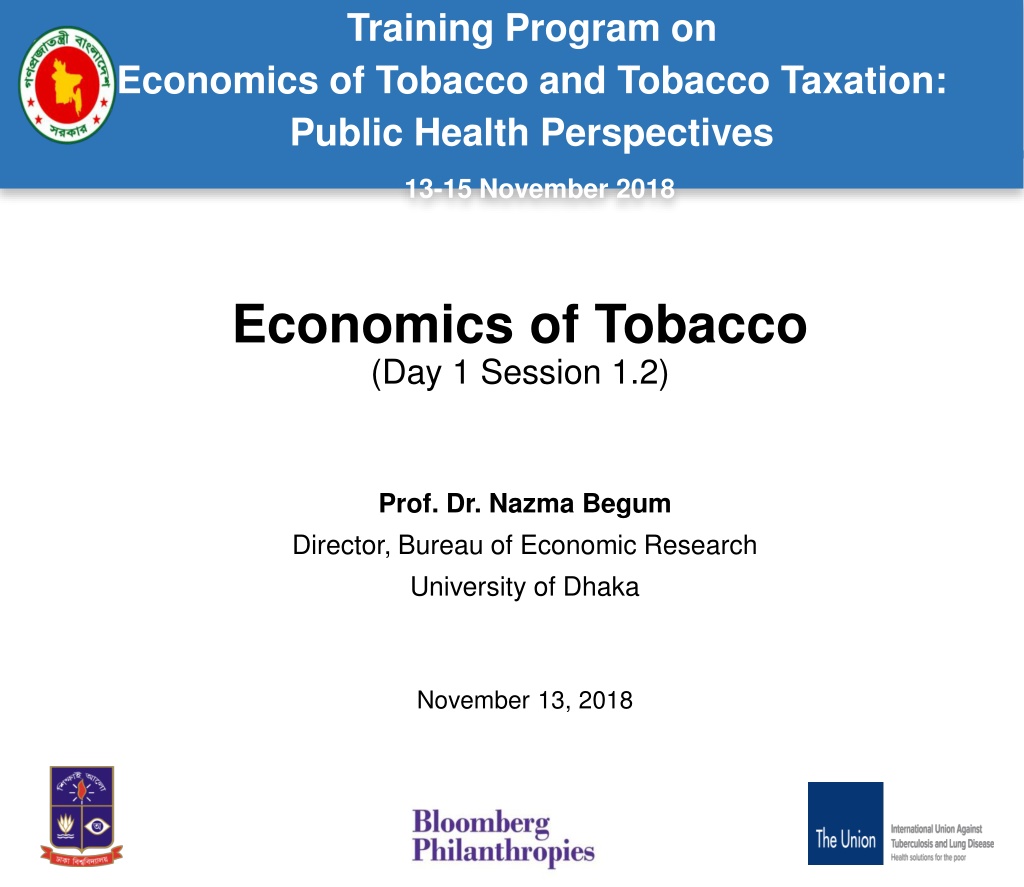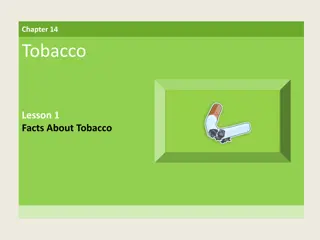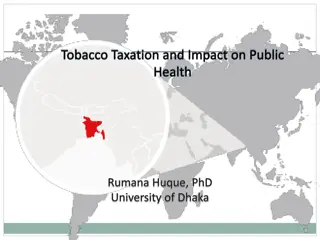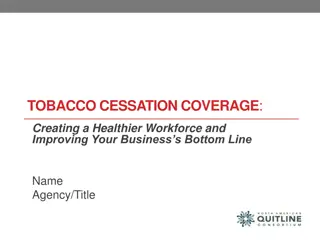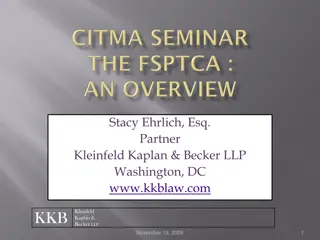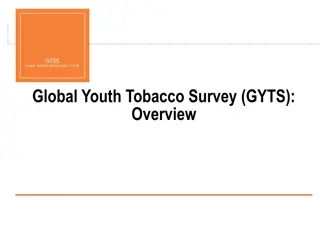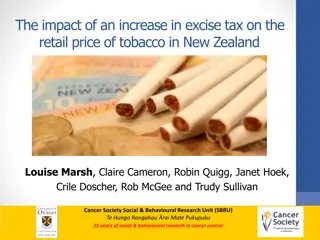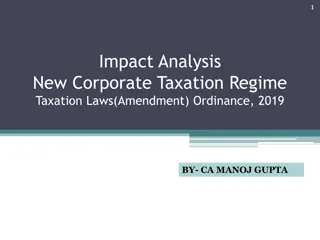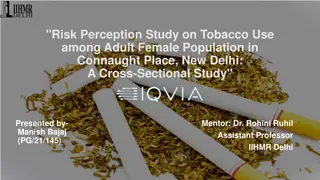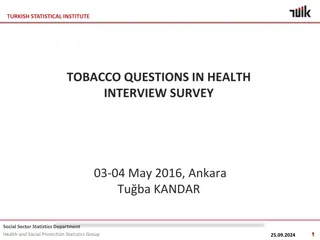Understanding Economics of Tobacco and Tobacco Taxation: Insights from Public Health Perspectives
Delve into the foundational concepts of demand in economics as applied to tobacco products, with a focus on the relationship between price and quantity demanded. Explore how demand curves shift and the impact of factors such as advertising, income, and government policies on the demand for cigarettes. Gain insights into nominal vs. real prices in the context of tobacco economics.
Download Presentation

Please find below an Image/Link to download the presentation.
The content on the website is provided AS IS for your information and personal use only. It may not be sold, licensed, or shared on other websites without obtaining consent from the author. Download presentation by click this link. If you encounter any issues during the download, it is possible that the publisher has removed the file from their server.
E N D
Presentation Transcript
Training Program on Economics of Tobacco and Tobacco Taxation: Public Health Perspectives 13-15 November 2018 Economics of Tobacco (Day 1 Session 1.2) Prof. Dr. Nazma Begum Director, Bureau of Economic Research University of Dhaka November 13, 2018
Basic concepts (Demand) Different combinations of the price and the quantity that people are willing and able to buy, during a specific period of time, given their incomes and tastes and preferences and all other things. If all other things are constant, then when price increases, quantity demanded decreases and vice versa. There is an inverse or negative relationship between price & quantity demanded when all other things remain constant. This is called the law of demand. 2 N. Begum: Economics of Tobacco
A hypothetical example Price per pack of cigarettes (BDT) Quantity demanded 0 25 50 75 100 125 150 175 200 1100 1000 900 800 700 600 500 400 300 3 N. Begum: Economics of Tobacco
Presenting this graphically 4 N. Begum: Economics of Tobacco
Some comments Demand curve graphically presents the relationship between demand and price This is a negative relationship Can the demand curve shift? Distinguish between a shift of the demand curve and a movement along the demand curve 5 N. Begum: Economics of Tobacco
Shifting the demand curve The demand curve shifts if any of the following changes: Tastes and preferences Income Advertising Price of substitute goods (and other things) 6 N. Begum: Economics of Tobacco
Shifting demand curve graphically 7 N. Begum: Economics of Tobacco
Some examples Consider the demand for cigarettes. What will happen to the demand curve if the following things happen? Tobacco advertising is banned Indoor smoking is banned The government increases the excise tax on cigarettes 8 N. Begum: Economics of Tobacco
Nominal vs. real price Nominal price: The price that you see in the shop/retail outlet It changes (increases) from year to year Real price An artificial price that removes the impact of inflation (i.e. the fact that prices in general are increasing) It is typically used to determine whether product X is becoming relatively cheaper or more expensive over time Can the nominal price increase and the real price decrease at the same time? 9 N. Begum: Economics of Tobacco
Elasticity Responsiveness By how much does something change in response to a 1% change in something else 10 N. Begum: Economics of Tobacco
Price elasticity of demand Definition: By how much does consumption of good X change in response to a 1% increase (or decrease) in the price of the good Formula: Percentage change in Qd/percentage change in P Relatively elastic vs. relatively inelastic demand: Ep between 0 and -1: relatively inelastic Ep greater than -1 (in absolute terms): relatively elastic N. Begum: Economics of Tobacco 11
Interpreting the measure What would happen to consumption of a product if the price increases by 1% and the price elasticity of demand was: -0.5? -1.2? 0? 1. If the price increases from 100 Taka to 110 Taka and the price elasticity of demand is -0.6, by what percentage would consumption decrease? 2. 12 N. Begum: Economics of Tobacco
Presenting elasticity graphically 13 N. Begum: Economics of Tobacco
How does price elasticity work in practice? An example At the outset: 1000 smokers, each smoking 100 cigarettes; total consumption is 100 000 cigarettes Price = 200 taka Price elasticity of demand = -0.6 Assume that price increases by 10% As a result consumption drops by 10 x 0.6 = 6% New consumption = 94 000 Two questions: What happens to the number of smokers? Are remaining smokers going to reduce their smoking? 14 N. Begum: Economics of Tobacco
Elasticity Cross price elasticity of demand Measures the extent that the quantity demanded of one good changes when the price of another good changes Elastic demand Elasticity less than 1.0 The quantity demanded decreases proportionately more than the price increases Inelastic demand Elasticity greater than 1.0 The quantity demanded decreases by less than the percentage increase in price Evidence shows that demand for smoking is inelastic 15 N. Begum: Economics of Tobacco
Understanding the decrease in consumption better International evidence: About 50% of decrease in consumption is due to people quitting and the other 50% due to remaining smokers smoking less on average Thus in this example Number of smokers decrease by 3% from 1000 to 970 Average cigarette consumption by remaining smokers decreases by 3% from 100 to 97 cigarettes Some smokers are completely unaffected by the price; others are A possible (one of an infinite number) outcome is the following: 679 smokers continue smoking at 100 cigarettes 291 smokers reduce their smoking to 90 cigarettes 16 N. Begum: Economics of Tobacco
What is the magnitude of the price elasticity of demand for tobacco? Many studies have estimated the price elasticity of demand for tobacco Initially only in high-income countries, especially the US Since the early 1990s increasingly in LMICs Different data sets and techniques The results are consistent Price elasticity lies in inelastic range (between 0 and -1) Most estimates lie between -0.4 and -0.8 Demand for tobacco is often more price inelastic in HICs than in LMICs Lower income groups and young people are 17 N. Begum: Economics of Tobacco
Bangladesh Overall price elasticity of cigarette demand is 0.49, which is less than 1 Which means that a given percentage increase in cigarette price leads to a less than proportionate decrease in cigarette consumption This will result in higher tobacco expenditure along with higher tax revenue for the government. In Bangladesh the impact of increasing price through taxation would have a considerably greater impact on reducing health harms of tobacco use 18 N. Begum: Economics of Tobacco
Increased taxes and price Effectiveness of excise tax as a tool to reduce tobacco use depends on how the tax increase impacts the retail price of the product. People change their purchasing behavior in response to retail price changes An excise tax increase typically increases the price of cigarettes. The magnitude of the price increase depends on the degree to which the tax increase is passed through to 19 N. Begum: Economics of Tobacco
Tax pass-through Tax pass-through: The degree to which the tax increase is passed onto consumers in the form of higher retail prices If the tax increases by R2, and the (net-of-VAT) price increases by Less than R2 under shifting More than R2 over shifting Exactly R2 full pass-through 20 N. Begum: Economics of Tobacco
Increased taxes and price Increasing the excise tax on cigarettes is a win-win situation: Reduces consumption Increases government revenues The evidence that the price elasticity of demand for cigarettes is in the inelastic range is so strong, that one can safely apply this knowledge to countries that do not have the data to allow one to estimate the price elasticity 21 N. Begum: Economics of Tobacco
Thank you R. Bitran for 2nd Bangladesh Flagship 22
